Analyzing the Relationship between Health, Lifestyle, and Environmental Factors
VerifiedAdded on 2019/12/28
|12
|4162
|107
Essay
AI Summary
The provided assignment content consists of a list of various academic sources, including journal articles and books, on topics such as health economics, public health, infectious diseases, and urban health. The sources cover a range of issues, from the economic evaluation of healthcare programs to the impact of lifestyle factors on fracture risk in older patients with cardiovascular disease. The content also includes studies on mental health priorities, tuberculosis incidence among people living with HIV, and the effects of Ebola on children. Additionally, there are references to books on infectious disease eradication and urban health research. Finally, the content includes online resources related to breast cancer screening programs and public healthcare.
Contribute Materials
Your contribution can guide someone’s learning journey. Share your
documents today.

Public Health
Secure Best Marks with AI Grader
Need help grading? Try our AI Grader for instant feedback on your assignments.
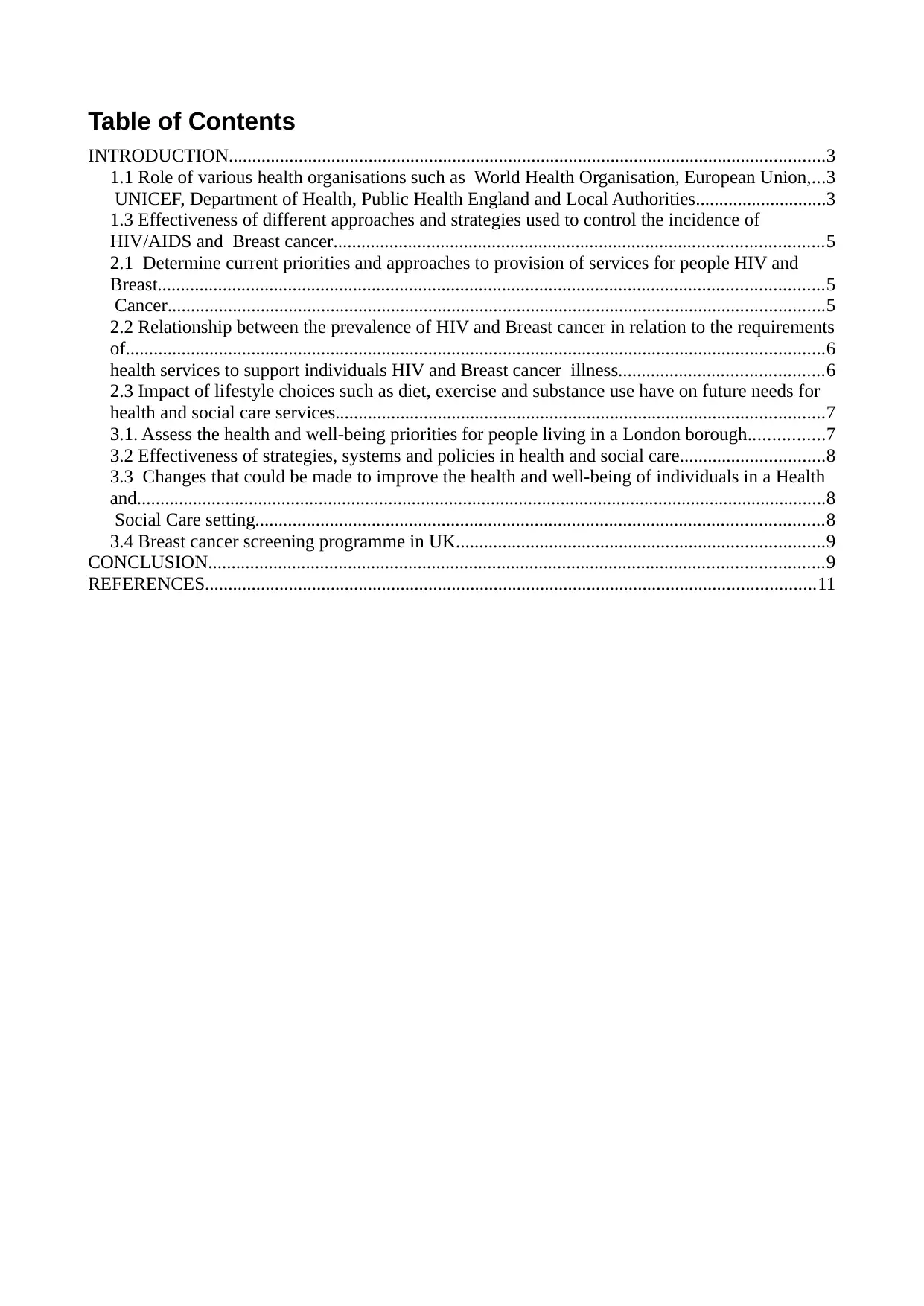
Table of Contents
INTRODUCTION................................................................................................................................3
1.1 Role of various health organisations such as World Health Organisation, European Union,...3
UNICEF, Department of Health, Public Health England and Local Authorities............................3
1.3 Effectiveness of different approaches and strategies used to control the incidence of
HIV/AIDS and Breast cancer.........................................................................................................5
2.1 Determine current priorities and approaches to provision of services for people HIV and
Breast...............................................................................................................................................5
Cancer.............................................................................................................................................5
2.2 Relationship between the prevalence of HIV and Breast cancer in relation to the requirements
of......................................................................................................................................................6
health services to support individuals HIV and Breast cancer illness............................................6
2.3 Impact of lifestyle choices such as diet, exercise and substance use have on future needs for
health and social care services.........................................................................................................7
3.1. Assess the health and well-being priorities for people living in a London borough................7
3.2 Effectiveness of strategies, systems and policies in health and social care...............................8
3.3 Changes that could be made to improve the health and well-being of individuals in a Health
and....................................................................................................................................................8
Social Care setting..........................................................................................................................8
3.4 Breast cancer screening programme in UK...............................................................................9
CONCLUSION....................................................................................................................................9
REFERENCES...................................................................................................................................11
INTRODUCTION................................................................................................................................3
1.1 Role of various health organisations such as World Health Organisation, European Union,...3
UNICEF, Department of Health, Public Health England and Local Authorities............................3
1.3 Effectiveness of different approaches and strategies used to control the incidence of
HIV/AIDS and Breast cancer.........................................................................................................5
2.1 Determine current priorities and approaches to provision of services for people HIV and
Breast...............................................................................................................................................5
Cancer.............................................................................................................................................5
2.2 Relationship between the prevalence of HIV and Breast cancer in relation to the requirements
of......................................................................................................................................................6
health services to support individuals HIV and Breast cancer illness............................................6
2.3 Impact of lifestyle choices such as diet, exercise and substance use have on future needs for
health and social care services.........................................................................................................7
3.1. Assess the health and well-being priorities for people living in a London borough................7
3.2 Effectiveness of strategies, systems and policies in health and social care...............................8
3.3 Changes that could be made to improve the health and well-being of individuals in a Health
and....................................................................................................................................................8
Social Care setting..........................................................................................................................8
3.4 Breast cancer screening programme in UK...............................................................................9
CONCLUSION....................................................................................................................................9
REFERENCES...................................................................................................................................11
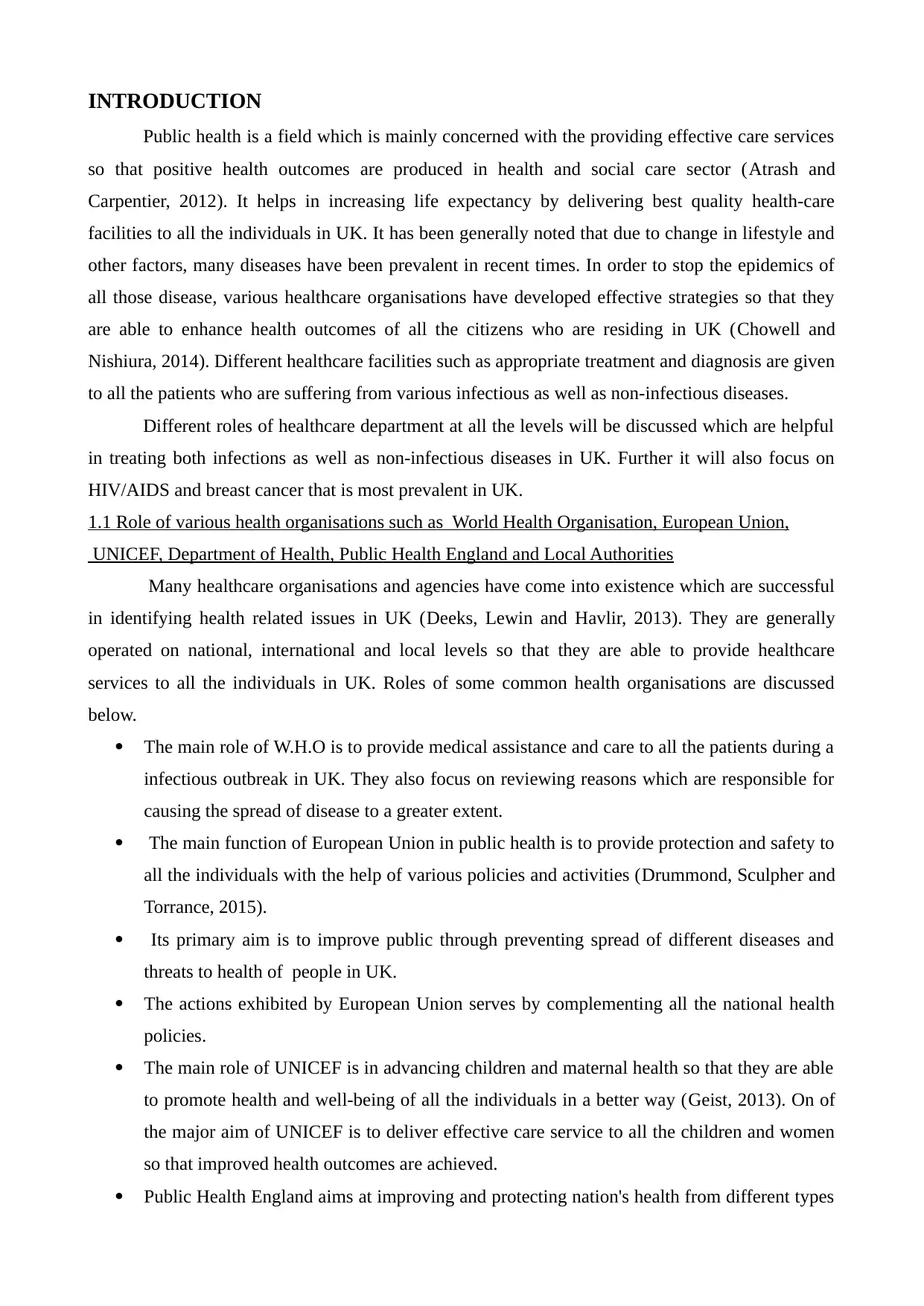
INTRODUCTION
Public health is a field which is mainly concerned with the providing effective care services
so that positive health outcomes are produced in health and social care sector (Atrash and
Carpentier, 2012). It helps in increasing life expectancy by delivering best quality health-care
facilities to all the individuals in UK. It has been generally noted that due to change in lifestyle and
other factors, many diseases have been prevalent in recent times. In order to stop the epidemics of
all those disease, various healthcare organisations have developed effective strategies so that they
are able to enhance health outcomes of all the citizens who are residing in UK (Chowell and
Nishiura, 2014). Different healthcare facilities such as appropriate treatment and diagnosis are given
to all the patients who are suffering from various infectious as well as non-infectious diseases.
Different roles of healthcare department at all the levels will be discussed which are helpful
in treating both infections as well as non-infectious diseases in UK. Further it will also focus on
HIV/AIDS and breast cancer that is most prevalent in UK.
1.1 Role of various health organisations such as World Health Organisation, European Union,
UNICEF, Department of Health, Public Health England and Local Authorities
Many healthcare organisations and agencies have come into existence which are successful
in identifying health related issues in UK (Deeks, Lewin and Havlir, 2013). They are generally
operated on national, international and local levels so that they are able to provide healthcare
services to all the individuals in UK. Roles of some common health organisations are discussed
below.
The main role of W.H.O is to provide medical assistance and care to all the patients during a
infectious outbreak in UK. They also focus on reviewing reasons which are responsible for
causing the spread of disease to a greater extent.
The main function of European Union in public health is to provide protection and safety to
all the individuals with the help of various policies and activities (Drummond, Sculpher and
Torrance, 2015).
Its primary aim is to improve public through preventing spread of different diseases and
threats to health of people in UK.
The actions exhibited by European Union serves by complementing all the national health
policies.
The main role of UNICEF is in advancing children and maternal health so that they are able
to promote health and well-being of all the individuals in a better way (Geist, 2013). On of
the major aim of UNICEF is to deliver effective care service to all the children and women
so that improved health outcomes are achieved.
Public Health England aims at improving and protecting nation's health from different types
Public health is a field which is mainly concerned with the providing effective care services
so that positive health outcomes are produced in health and social care sector (Atrash and
Carpentier, 2012). It helps in increasing life expectancy by delivering best quality health-care
facilities to all the individuals in UK. It has been generally noted that due to change in lifestyle and
other factors, many diseases have been prevalent in recent times. In order to stop the epidemics of
all those disease, various healthcare organisations have developed effective strategies so that they
are able to enhance health outcomes of all the citizens who are residing in UK (Chowell and
Nishiura, 2014). Different healthcare facilities such as appropriate treatment and diagnosis are given
to all the patients who are suffering from various infectious as well as non-infectious diseases.
Different roles of healthcare department at all the levels will be discussed which are helpful
in treating both infections as well as non-infectious diseases in UK. Further it will also focus on
HIV/AIDS and breast cancer that is most prevalent in UK.
1.1 Role of various health organisations such as World Health Organisation, European Union,
UNICEF, Department of Health, Public Health England and Local Authorities
Many healthcare organisations and agencies have come into existence which are successful
in identifying health related issues in UK (Deeks, Lewin and Havlir, 2013). They are generally
operated on national, international and local levels so that they are able to provide healthcare
services to all the individuals in UK. Roles of some common health organisations are discussed
below.
The main role of W.H.O is to provide medical assistance and care to all the patients during a
infectious outbreak in UK. They also focus on reviewing reasons which are responsible for
causing the spread of disease to a greater extent.
The main function of European Union in public health is to provide protection and safety to
all the individuals with the help of various policies and activities (Drummond, Sculpher and
Torrance, 2015).
Its primary aim is to improve public through preventing spread of different diseases and
threats to health of people in UK.
The actions exhibited by European Union serves by complementing all the national health
policies.
The main role of UNICEF is in advancing children and maternal health so that they are able
to promote health and well-being of all the individuals in a better way (Geist, 2013). On of
the major aim of UNICEF is to deliver effective care service to all the children and women
so that improved health outcomes are achieved.
Public Health England aims at improving and protecting nation's health from different types

of hazards and risk related to environment. It mainly employs more than 5'500 staff
members which are able to address health inequalities and issues.
1.2 Epidemiology of HIV and Breast Cancer in UK
Epidemiology is briefly defined as adopting methods which can successfully determine
major reasons behind the prevalence of different disease that are present in UK. Different types of
approaches have been taken into account so that dreadful diseases such as HIV/AIDS and Breast-
cancer can be effectively minimized (Khatib, Yusuf and Mente, 2014). Epidemiological data table
for HIV/AIDS and Breast Cancer has been given in the below table.
Country People
Infected
with
HIV/AIDS
Adults
(16-50)
Prevalence
%
Females
with
HIV/AIDS
Children
with
HIV/AIDS
AIDS deaths Orphanage
deaths due to
AIDS
United
Kingdom
3550000 17.00% 1750050 265000 155000 1860000
Table 1: HIV/AIDS Victims in United Kingdom in 2015
Country Females
infected with
Breast Cancer
Prevalence
%
Deaths
due to
Breast
Cancer.
United
Kingdo
m.
1100000 19.7.00% 120000
Table 2: Breast Cancer infected Females in United Kingdom in 2015
Based on the above table it can be concluded that more than 35 million citizens of UK are
prone to HIV/AIDS which has contributed to more than 17% of the total population of UK.
Along with HIV/AIDS overall case of more than 11 million females have been diagnosed
with breast cancer in 2015 and overall mortality rate of breast cancer in the nation is more
than 9% (Mehta, Croudace and Davies, 2015).
After other African nations, United Kingdom has been the second largest country which has
recorded maximum number of breast cancer and HIV/AIDS cases in the year 2015.
members which are able to address health inequalities and issues.
1.2 Epidemiology of HIV and Breast Cancer in UK
Epidemiology is briefly defined as adopting methods which can successfully determine
major reasons behind the prevalence of different disease that are present in UK. Different types of
approaches have been taken into account so that dreadful diseases such as HIV/AIDS and Breast-
cancer can be effectively minimized (Khatib, Yusuf and Mente, 2014). Epidemiological data table
for HIV/AIDS and Breast Cancer has been given in the below table.
Country People
Infected
with
HIV/AIDS
Adults
(16-50)
Prevalence
%
Females
with
HIV/AIDS
Children
with
HIV/AIDS
AIDS deaths Orphanage
deaths due to
AIDS
United
Kingdom
3550000 17.00% 1750050 265000 155000 1860000
Table 1: HIV/AIDS Victims in United Kingdom in 2015
Country Females
infected with
Breast Cancer
Prevalence
%
Deaths
due to
Breast
Cancer.
United
Kingdo
m.
1100000 19.7.00% 120000
Table 2: Breast Cancer infected Females in United Kingdom in 2015
Based on the above table it can be concluded that more than 35 million citizens of UK are
prone to HIV/AIDS which has contributed to more than 17% of the total population of UK.
Along with HIV/AIDS overall case of more than 11 million females have been diagnosed
with breast cancer in 2015 and overall mortality rate of breast cancer in the nation is more
than 9% (Mehta, Croudace and Davies, 2015).
After other African nations, United Kingdom has been the second largest country which has
recorded maximum number of breast cancer and HIV/AIDS cases in the year 2015.
Secure Best Marks with AI Grader
Need help grading? Try our AI Grader for instant feedback on your assignments.
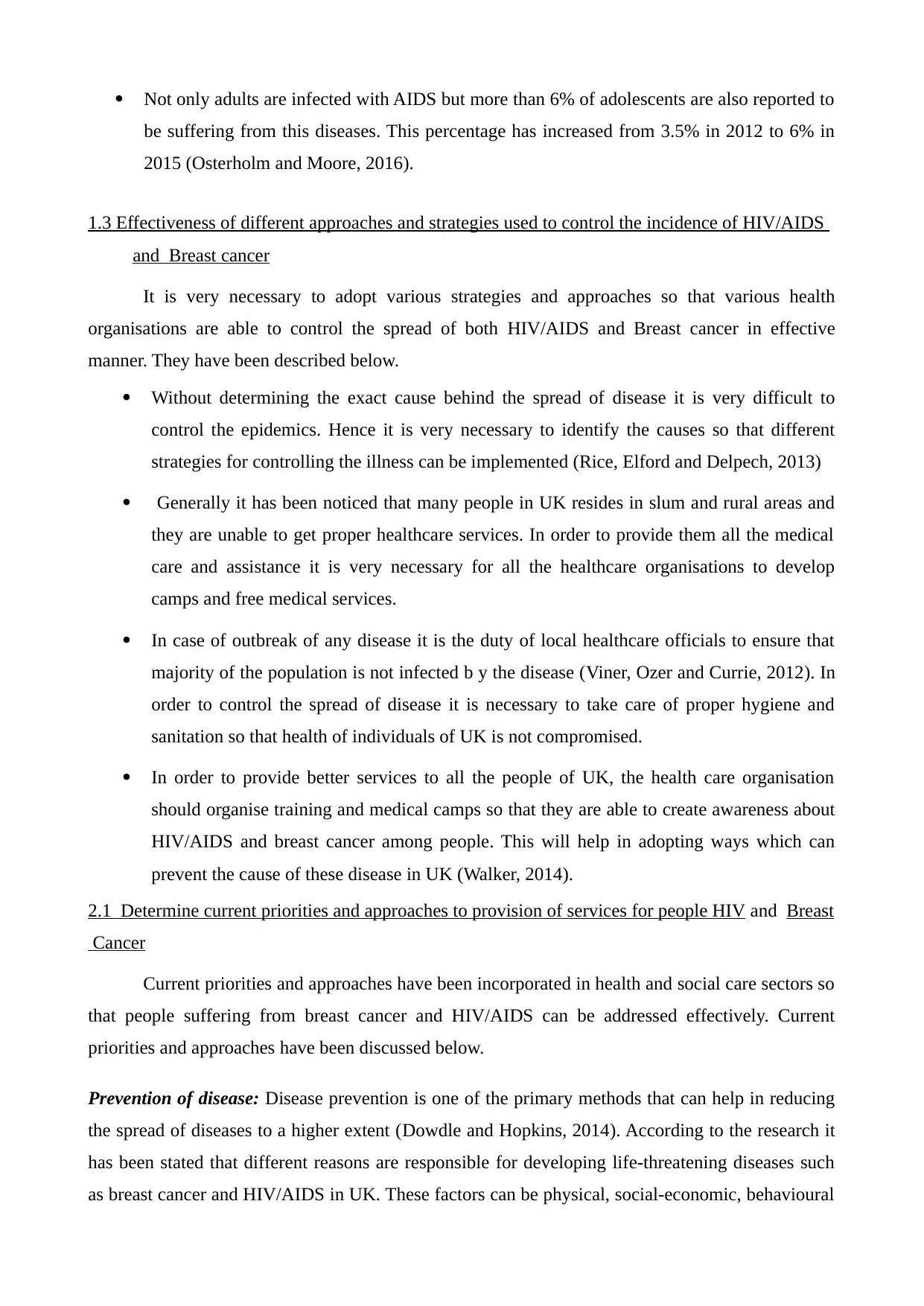
Not only adults are infected with AIDS but more than 6% of adolescents are also reported to
be suffering from this diseases. This percentage has increased from 3.5% in 2012 to 6% in
2015 (Osterholm and Moore, 2016).
1.3 Effectiveness of different approaches and strategies used to control the incidence of HIV/AIDS
and Breast cancer
It is very necessary to adopt various strategies and approaches so that various health
organisations are able to control the spread of both HIV/AIDS and Breast cancer in effective
manner. They have been described below.
Without determining the exact cause behind the spread of disease it is very difficult to
control the epidemics. Hence it is very necessary to identify the causes so that different
strategies for controlling the illness can be implemented (Rice, Elford and Delpech, 2013)
Generally it has been noticed that many people in UK resides in slum and rural areas and
they are unable to get proper healthcare services. In order to provide them all the medical
care and assistance it is very necessary for all the healthcare organisations to develop
camps and free medical services.
In case of outbreak of any disease it is the duty of local healthcare officials to ensure that
majority of the population is not infected b y the disease (Viner, Ozer and Currie, 2012). In
order to control the spread of disease it is necessary to take care of proper hygiene and
sanitation so that health of individuals of UK is not compromised.
In order to provide better services to all the people of UK, the health care organisation
should organise training and medical camps so that they are able to create awareness about
HIV/AIDS and breast cancer among people. This will help in adopting ways which can
prevent the cause of these disease in UK (Walker, 2014).
2.1 Determine current priorities and approaches to provision of services for people HIV and Breast
Cancer
Current priorities and approaches have been incorporated in health and social care sectors so
that people suffering from breast cancer and HIV/AIDS can be addressed effectively. Current
priorities and approaches have been discussed below.
Prevention of disease: Disease prevention is one of the primary methods that can help in reducing
the spread of diseases to a higher extent (Dowdle and Hopkins, 2014). According to the research it
has been stated that different reasons are responsible for developing life-threatening diseases such
as breast cancer and HIV/AIDS in UK. These factors can be physical, social-economic, behavioural
be suffering from this diseases. This percentage has increased from 3.5% in 2012 to 6% in
2015 (Osterholm and Moore, 2016).
1.3 Effectiveness of different approaches and strategies used to control the incidence of HIV/AIDS
and Breast cancer
It is very necessary to adopt various strategies and approaches so that various health
organisations are able to control the spread of both HIV/AIDS and Breast cancer in effective
manner. They have been described below.
Without determining the exact cause behind the spread of disease it is very difficult to
control the epidemics. Hence it is very necessary to identify the causes so that different
strategies for controlling the illness can be implemented (Rice, Elford and Delpech, 2013)
Generally it has been noticed that many people in UK resides in slum and rural areas and
they are unable to get proper healthcare services. In order to provide them all the medical
care and assistance it is very necessary for all the healthcare organisations to develop
camps and free medical services.
In case of outbreak of any disease it is the duty of local healthcare officials to ensure that
majority of the population is not infected b y the disease (Viner, Ozer and Currie, 2012). In
order to control the spread of disease it is necessary to take care of proper hygiene and
sanitation so that health of individuals of UK is not compromised.
In order to provide better services to all the people of UK, the health care organisation
should organise training and medical camps so that they are able to create awareness about
HIV/AIDS and breast cancer among people. This will help in adopting ways which can
prevent the cause of these disease in UK (Walker, 2014).
2.1 Determine current priorities and approaches to provision of services for people HIV and Breast
Cancer
Current priorities and approaches have been incorporated in health and social care sectors so
that people suffering from breast cancer and HIV/AIDS can be addressed effectively. Current
priorities and approaches have been discussed below.
Prevention of disease: Disease prevention is one of the primary methods that can help in reducing
the spread of diseases to a higher extent (Dowdle and Hopkins, 2014). According to the research it
has been stated that different reasons are responsible for developing life-threatening diseases such
as breast cancer and HIV/AIDS in UK. These factors can be physical, social-economic, behavioural
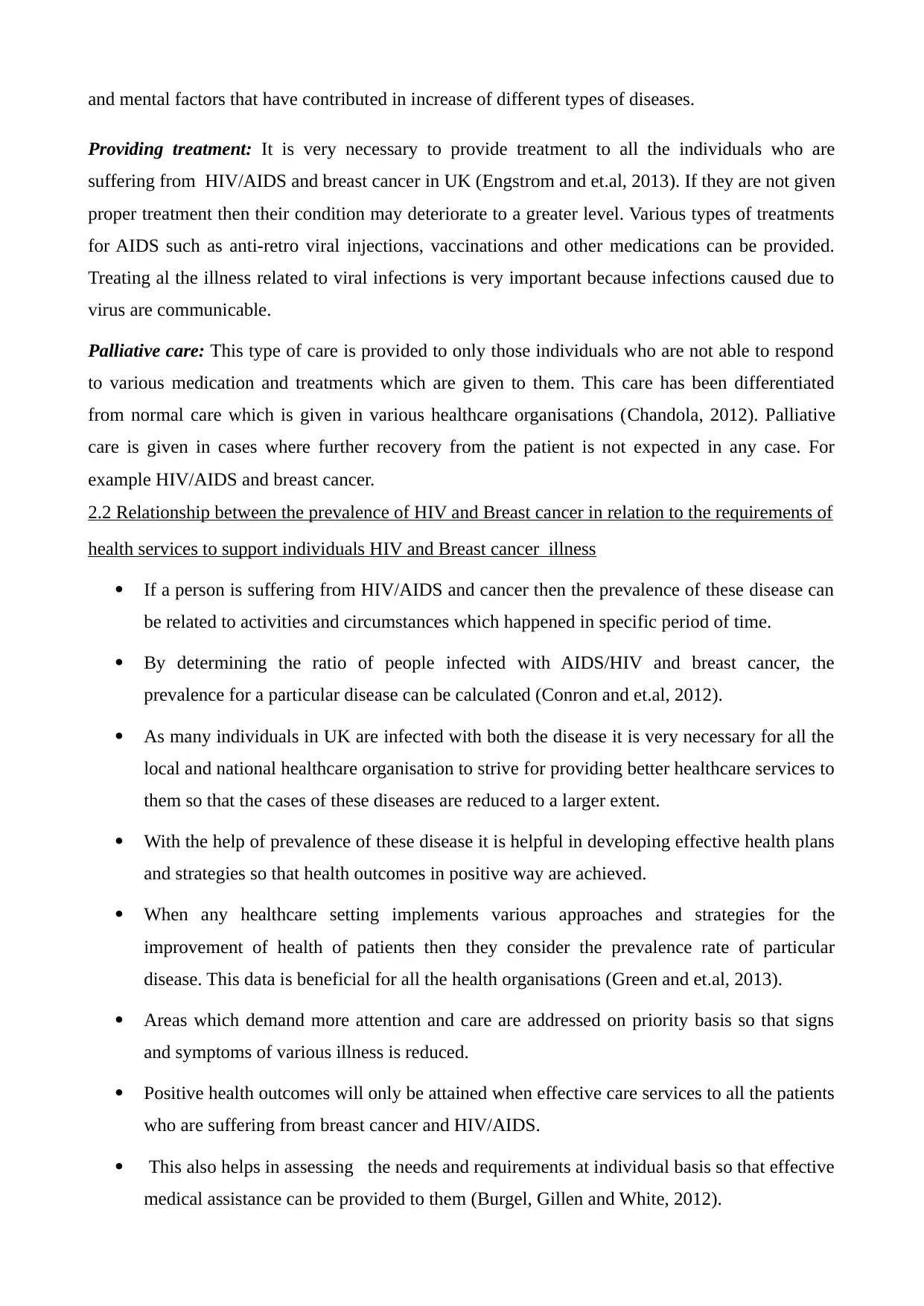
and mental factors that have contributed in increase of different types of diseases.
Providing treatment: It is very necessary to provide treatment to all the individuals who are
suffering from HIV/AIDS and breast cancer in UK (Engstrom and et.al, 2013). If they are not given
proper treatment then their condition may deteriorate to a greater level. Various types of treatments
for AIDS such as anti-retro viral injections, vaccinations and other medications can be provided.
Treating al the illness related to viral infections is very important because infections caused due to
virus are communicable.
Palliative care: This type of care is provided to only those individuals who are not able to respond
to various medication and treatments which are given to them. This care has been differentiated
from normal care which is given in various healthcare organisations (Chandola, 2012). Palliative
care is given in cases where further recovery from the patient is not expected in any case. For
example HIV/AIDS and breast cancer.
2.2 Relationship between the prevalence of HIV and Breast cancer in relation to the requirements of
health services to support individuals HIV and Breast cancer illness
If a person is suffering from HIV/AIDS and cancer then the prevalence of these disease can
be related to activities and circumstances which happened in specific period of time.
By determining the ratio of people infected with AIDS/HIV and breast cancer, the
prevalence for a particular disease can be calculated (Conron and et.al, 2012).
As many individuals in UK are infected with both the disease it is very necessary for all the
local and national healthcare organisation to strive for providing better healthcare services to
them so that the cases of these diseases are reduced to a larger extent.
With the help of prevalence of these disease it is helpful in developing effective health plans
and strategies so that health outcomes in positive way are achieved.
When any healthcare setting implements various approaches and strategies for the
improvement of health of patients then they consider the prevalence rate of particular
disease. This data is beneficial for all the health organisations (Green and et.al, 2013).
Areas which demand more attention and care are addressed on priority basis so that signs
and symptoms of various illness is reduced.
Positive health outcomes will only be attained when effective care services to all the patients
who are suffering from breast cancer and HIV/AIDS.
This also helps in assessing the needs and requirements at individual basis so that effective
medical assistance can be provided to them (Burgel, Gillen and White, 2012).
Providing treatment: It is very necessary to provide treatment to all the individuals who are
suffering from HIV/AIDS and breast cancer in UK (Engstrom and et.al, 2013). If they are not given
proper treatment then their condition may deteriorate to a greater level. Various types of treatments
for AIDS such as anti-retro viral injections, vaccinations and other medications can be provided.
Treating al the illness related to viral infections is very important because infections caused due to
virus are communicable.
Palliative care: This type of care is provided to only those individuals who are not able to respond
to various medication and treatments which are given to them. This care has been differentiated
from normal care which is given in various healthcare organisations (Chandola, 2012). Palliative
care is given in cases where further recovery from the patient is not expected in any case. For
example HIV/AIDS and breast cancer.
2.2 Relationship between the prevalence of HIV and Breast cancer in relation to the requirements of
health services to support individuals HIV and Breast cancer illness
If a person is suffering from HIV/AIDS and cancer then the prevalence of these disease can
be related to activities and circumstances which happened in specific period of time.
By determining the ratio of people infected with AIDS/HIV and breast cancer, the
prevalence for a particular disease can be calculated (Conron and et.al, 2012).
As many individuals in UK are infected with both the disease it is very necessary for all the
local and national healthcare organisation to strive for providing better healthcare services to
them so that the cases of these diseases are reduced to a larger extent.
With the help of prevalence of these disease it is helpful in developing effective health plans
and strategies so that health outcomes in positive way are achieved.
When any healthcare setting implements various approaches and strategies for the
improvement of health of patients then they consider the prevalence rate of particular
disease. This data is beneficial for all the health organisations (Green and et.al, 2013).
Areas which demand more attention and care are addressed on priority basis so that signs
and symptoms of various illness is reduced.
Positive health outcomes will only be attained when effective care services to all the patients
who are suffering from breast cancer and HIV/AIDS.
This also helps in assessing the needs and requirements at individual basis so that effective
medical assistance can be provided to them (Burgel, Gillen and White, 2012).
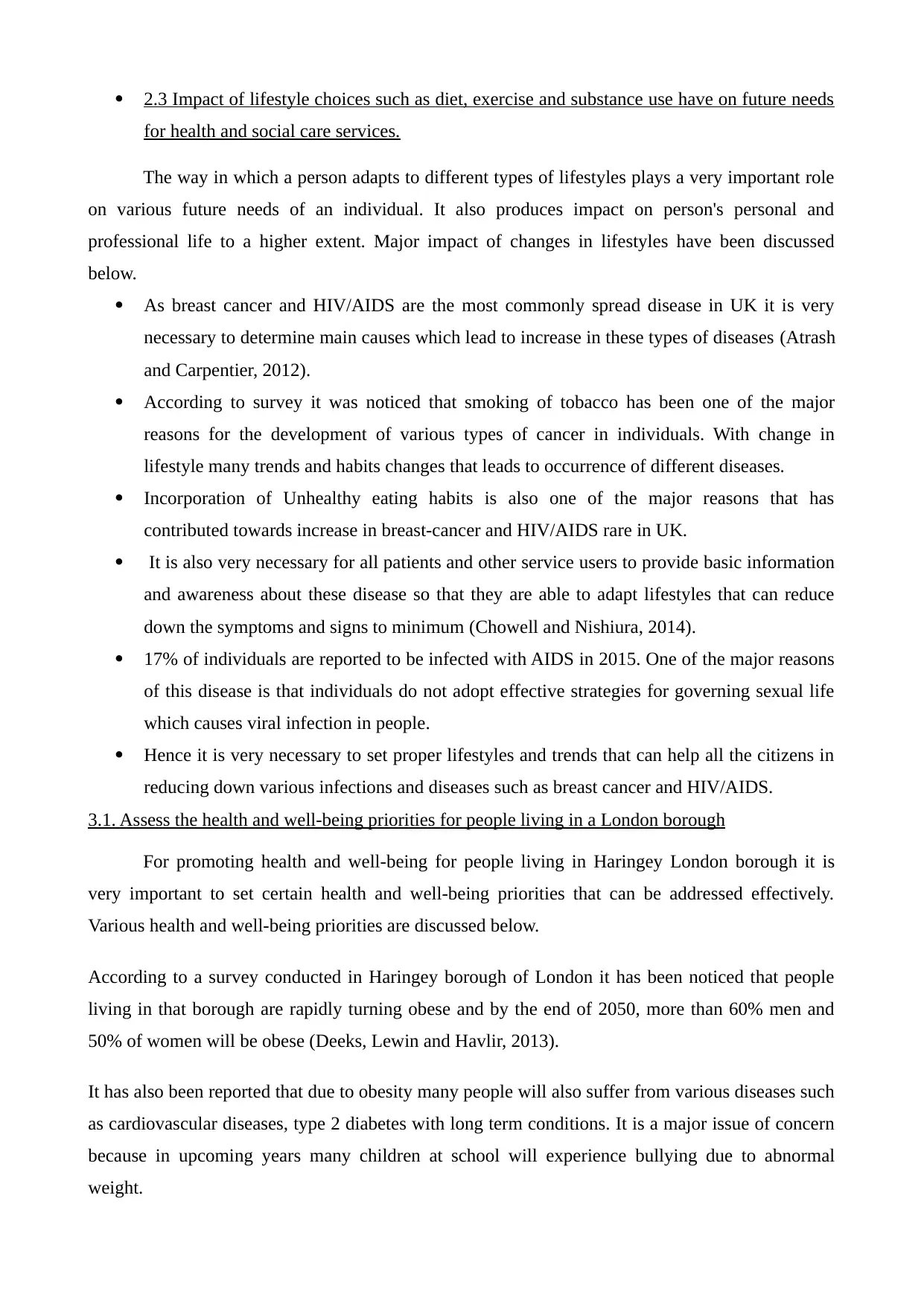
2.3 Impact of lifestyle choices such as diet, exercise and substance use have on future needs
for health and social care services.
The way in which a person adapts to different types of lifestyles plays a very important role
on various future needs of an individual. It also produces impact on person's personal and
professional life to a higher extent. Major impact of changes in lifestyles have been discussed
below.
As breast cancer and HIV/AIDS are the most commonly spread disease in UK it is very
necessary to determine main causes which lead to increase in these types of diseases (Atrash
and Carpentier, 2012).
According to survey it was noticed that smoking of tobacco has been one of the major
reasons for the development of various types of cancer in individuals. With change in
lifestyle many trends and habits changes that leads to occurrence of different diseases.
Incorporation of Unhealthy eating habits is also one of the major reasons that has
contributed towards increase in breast-cancer and HIV/AIDS rare in UK.
It is also very necessary for all patients and other service users to provide basic information
and awareness about these disease so that they are able to adapt lifestyles that can reduce
down the symptoms and signs to minimum (Chowell and Nishiura, 2014).
17% of individuals are reported to be infected with AIDS in 2015. One of the major reasons
of this disease is that individuals do not adopt effective strategies for governing sexual life
which causes viral infection in people.
Hence it is very necessary to set proper lifestyles and trends that can help all the citizens in
reducing down various infections and diseases such as breast cancer and HIV/AIDS.
3.1. Assess the health and well-being priorities for people living in a London borough
For promoting health and well-being for people living in Haringey London borough it is
very important to set certain health and well-being priorities that can be addressed effectively.
Various health and well-being priorities are discussed below.
According to a survey conducted in Haringey borough of London it has been noticed that people
living in that borough are rapidly turning obese and by the end of 2050, more than 60% men and
50% of women will be obese (Deeks, Lewin and Havlir, 2013).
It has also been reported that due to obesity many people will also suffer from various diseases such
as cardiovascular diseases, type 2 diabetes with long term conditions. It is a major issue of concern
because in upcoming years many children at school will experience bullying due to abnormal
weight.
for health and social care services.
The way in which a person adapts to different types of lifestyles plays a very important role
on various future needs of an individual. It also produces impact on person's personal and
professional life to a higher extent. Major impact of changes in lifestyles have been discussed
below.
As breast cancer and HIV/AIDS are the most commonly spread disease in UK it is very
necessary to determine main causes which lead to increase in these types of diseases (Atrash
and Carpentier, 2012).
According to survey it was noticed that smoking of tobacco has been one of the major
reasons for the development of various types of cancer in individuals. With change in
lifestyle many trends and habits changes that leads to occurrence of different diseases.
Incorporation of Unhealthy eating habits is also one of the major reasons that has
contributed towards increase in breast-cancer and HIV/AIDS rare in UK.
It is also very necessary for all patients and other service users to provide basic information
and awareness about these disease so that they are able to adapt lifestyles that can reduce
down the symptoms and signs to minimum (Chowell and Nishiura, 2014).
17% of individuals are reported to be infected with AIDS in 2015. One of the major reasons
of this disease is that individuals do not adopt effective strategies for governing sexual life
which causes viral infection in people.
Hence it is very necessary to set proper lifestyles and trends that can help all the citizens in
reducing down various infections and diseases such as breast cancer and HIV/AIDS.
3.1. Assess the health and well-being priorities for people living in a London borough
For promoting health and well-being for people living in Haringey London borough it is
very important to set certain health and well-being priorities that can be addressed effectively.
Various health and well-being priorities are discussed below.
According to a survey conducted in Haringey borough of London it has been noticed that people
living in that borough are rapidly turning obese and by the end of 2050, more than 60% men and
50% of women will be obese (Deeks, Lewin and Havlir, 2013).
It has also been reported that due to obesity many people will also suffer from various diseases such
as cardiovascular diseases, type 2 diabetes with long term conditions. It is a major issue of concern
because in upcoming years many children at school will experience bullying due to abnormal
weight.
Paraphrase This Document
Need a fresh take? Get an instant paraphrase of this document with our AI Paraphraser
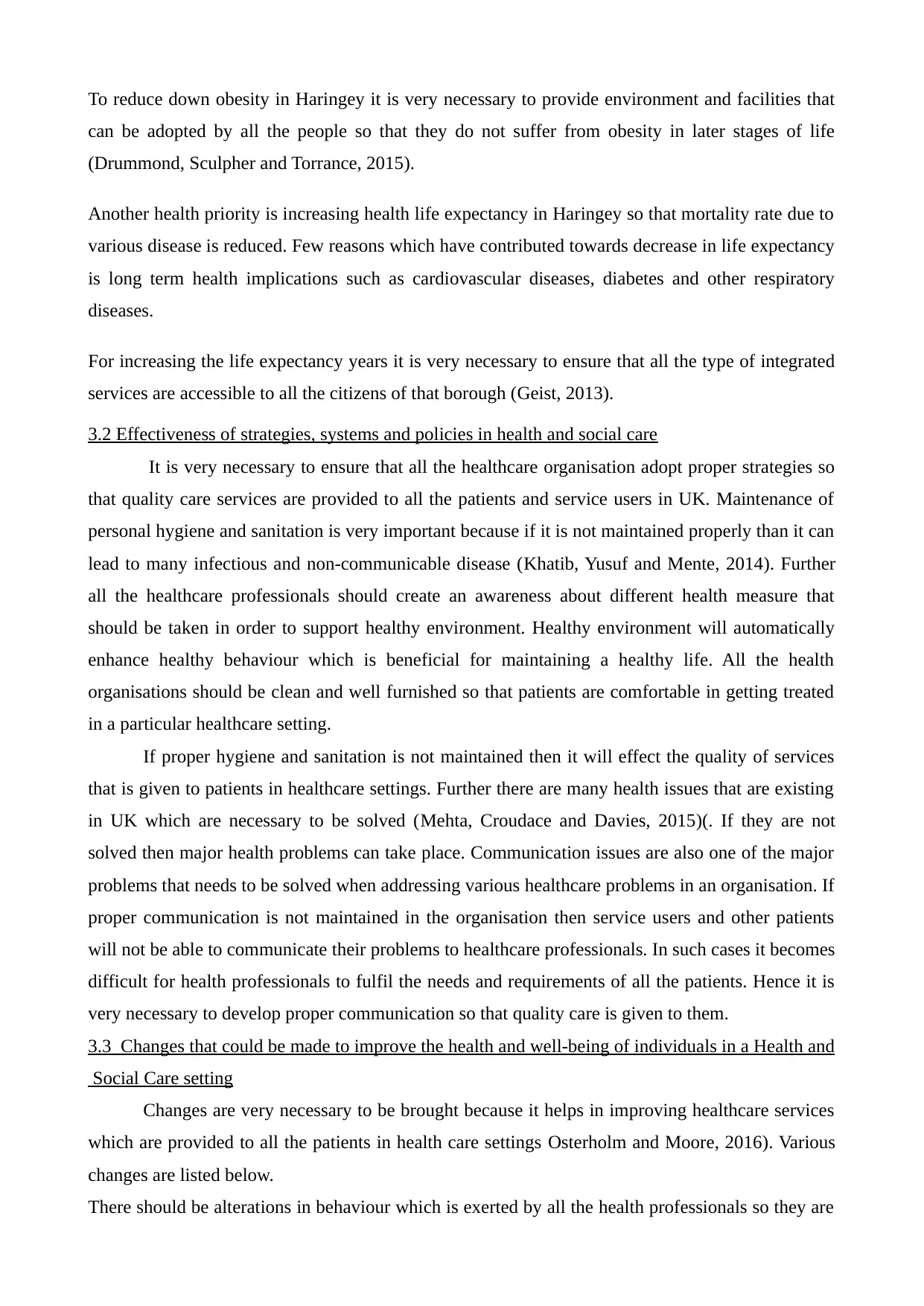
To reduce down obesity in Haringey it is very necessary to provide environment and facilities that
can be adopted by all the people so that they do not suffer from obesity in later stages of life
(Drummond, Sculpher and Torrance, 2015).
Another health priority is increasing health life expectancy in Haringey so that mortality rate due to
various disease is reduced. Few reasons which have contributed towards decrease in life expectancy
is long term health implications such as cardiovascular diseases, diabetes and other respiratory
diseases.
For increasing the life expectancy years it is very necessary to ensure that all the type of integrated
services are accessible to all the citizens of that borough (Geist, 2013).
3.2 Effectiveness of strategies, systems and policies in health and social care
It is very necessary to ensure that all the healthcare organisation adopt proper strategies so
that quality care services are provided to all the patients and service users in UK. Maintenance of
personal hygiene and sanitation is very important because if it is not maintained properly than it can
lead to many infectious and non-communicable disease (Khatib, Yusuf and Mente, 2014). Further
all the healthcare professionals should create an awareness about different health measure that
should be taken in order to support healthy environment. Healthy environment will automatically
enhance healthy behaviour which is beneficial for maintaining a healthy life. All the health
organisations should be clean and well furnished so that patients are comfortable in getting treated
in a particular healthcare setting.
If proper hygiene and sanitation is not maintained then it will effect the quality of services
that is given to patients in healthcare settings. Further there are many health issues that are existing
in UK which are necessary to be solved (Mehta, Croudace and Davies, 2015)(. If they are not
solved then major health problems can take place. Communication issues are also one of the major
problems that needs to be solved when addressing various healthcare problems in an organisation. If
proper communication is not maintained in the organisation then service users and other patients
will not be able to communicate their problems to healthcare professionals. In such cases it becomes
difficult for health professionals to fulfil the needs and requirements of all the patients. Hence it is
very necessary to develop proper communication so that quality care is given to them.
3.3 Changes that could be made to improve the health and well-being of individuals in a Health and
Social Care setting
Changes are very necessary to be brought because it helps in improving healthcare services
which are provided to all the patients in health care settings Osterholm and Moore, 2016). Various
changes are listed below.
There should be alterations in behaviour which is exerted by all the health professionals so they are
can be adopted by all the people so that they do not suffer from obesity in later stages of life
(Drummond, Sculpher and Torrance, 2015).
Another health priority is increasing health life expectancy in Haringey so that mortality rate due to
various disease is reduced. Few reasons which have contributed towards decrease in life expectancy
is long term health implications such as cardiovascular diseases, diabetes and other respiratory
diseases.
For increasing the life expectancy years it is very necessary to ensure that all the type of integrated
services are accessible to all the citizens of that borough (Geist, 2013).
3.2 Effectiveness of strategies, systems and policies in health and social care
It is very necessary to ensure that all the healthcare organisation adopt proper strategies so
that quality care services are provided to all the patients and service users in UK. Maintenance of
personal hygiene and sanitation is very important because if it is not maintained properly than it can
lead to many infectious and non-communicable disease (Khatib, Yusuf and Mente, 2014). Further
all the healthcare professionals should create an awareness about different health measure that
should be taken in order to support healthy environment. Healthy environment will automatically
enhance healthy behaviour which is beneficial for maintaining a healthy life. All the health
organisations should be clean and well furnished so that patients are comfortable in getting treated
in a particular healthcare setting.
If proper hygiene and sanitation is not maintained then it will effect the quality of services
that is given to patients in healthcare settings. Further there are many health issues that are existing
in UK which are necessary to be solved (Mehta, Croudace and Davies, 2015)(. If they are not
solved then major health problems can take place. Communication issues are also one of the major
problems that needs to be solved when addressing various healthcare problems in an organisation. If
proper communication is not maintained in the organisation then service users and other patients
will not be able to communicate their problems to healthcare professionals. In such cases it becomes
difficult for health professionals to fulfil the needs and requirements of all the patients. Hence it is
very necessary to develop proper communication so that quality care is given to them.
3.3 Changes that could be made to improve the health and well-being of individuals in a Health and
Social Care setting
Changes are very necessary to be brought because it helps in improving healthcare services
which are provided to all the patients in health care settings Osterholm and Moore, 2016). Various
changes are listed below.
There should be alterations in behaviour which is exerted by all the health professionals so they are
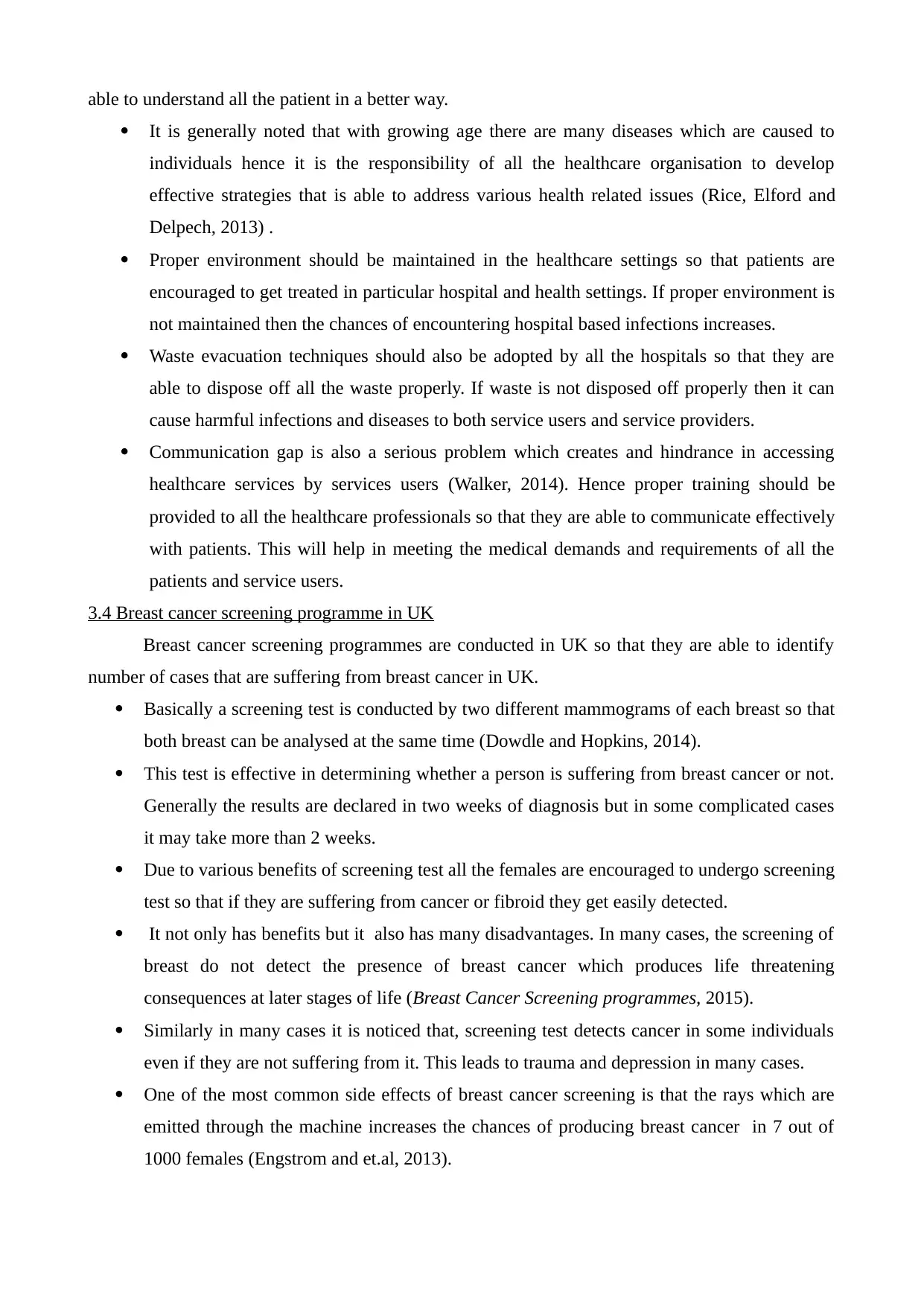
able to understand all the patient in a better way.
It is generally noted that with growing age there are many diseases which are caused to
individuals hence it is the responsibility of all the healthcare organisation to develop
effective strategies that is able to address various health related issues (Rice, Elford and
Delpech, 2013) .
Proper environment should be maintained in the healthcare settings so that patients are
encouraged to get treated in particular hospital and health settings. If proper environment is
not maintained then the chances of encountering hospital based infections increases.
Waste evacuation techniques should also be adopted by all the hospitals so that they are
able to dispose off all the waste properly. If waste is not disposed off properly then it can
cause harmful infections and diseases to both service users and service providers.
Communication gap is also a serious problem which creates and hindrance in accessing
healthcare services by services users (Walker, 2014). Hence proper training should be
provided to all the healthcare professionals so that they are able to communicate effectively
with patients. This will help in meeting the medical demands and requirements of all the
patients and service users.
3.4 Breast cancer screening programme in UK
Breast cancer screening programmes are conducted in UK so that they are able to identify
number of cases that are suffering from breast cancer in UK.
Basically a screening test is conducted by two different mammograms of each breast so that
both breast can be analysed at the same time (Dowdle and Hopkins, 2014).
This test is effective in determining whether a person is suffering from breast cancer or not.
Generally the results are declared in two weeks of diagnosis but in some complicated cases
it may take more than 2 weeks.
Due to various benefits of screening test all the females are encouraged to undergo screening
test so that if they are suffering from cancer or fibroid they get easily detected.
It not only has benefits but it also has many disadvantages. In many cases, the screening of
breast do not detect the presence of breast cancer which produces life threatening
consequences at later stages of life (Breast Cancer Screening programmes, 2015).
Similarly in many cases it is noticed that, screening test detects cancer in some individuals
even if they are not suffering from it. This leads to trauma and depression in many cases.
One of the most common side effects of breast cancer screening is that the rays which are
emitted through the machine increases the chances of producing breast cancer in 7 out of
1000 females (Engstrom and et.al, 2013).
It is generally noted that with growing age there are many diseases which are caused to
individuals hence it is the responsibility of all the healthcare organisation to develop
effective strategies that is able to address various health related issues (Rice, Elford and
Delpech, 2013) .
Proper environment should be maintained in the healthcare settings so that patients are
encouraged to get treated in particular hospital and health settings. If proper environment is
not maintained then the chances of encountering hospital based infections increases.
Waste evacuation techniques should also be adopted by all the hospitals so that they are
able to dispose off all the waste properly. If waste is not disposed off properly then it can
cause harmful infections and diseases to both service users and service providers.
Communication gap is also a serious problem which creates and hindrance in accessing
healthcare services by services users (Walker, 2014). Hence proper training should be
provided to all the healthcare professionals so that they are able to communicate effectively
with patients. This will help in meeting the medical demands and requirements of all the
patients and service users.
3.4 Breast cancer screening programme in UK
Breast cancer screening programmes are conducted in UK so that they are able to identify
number of cases that are suffering from breast cancer in UK.
Basically a screening test is conducted by two different mammograms of each breast so that
both breast can be analysed at the same time (Dowdle and Hopkins, 2014).
This test is effective in determining whether a person is suffering from breast cancer or not.
Generally the results are declared in two weeks of diagnosis but in some complicated cases
it may take more than 2 weeks.
Due to various benefits of screening test all the females are encouraged to undergo screening
test so that if they are suffering from cancer or fibroid they get easily detected.
It not only has benefits but it also has many disadvantages. In many cases, the screening of
breast do not detect the presence of breast cancer which produces life threatening
consequences at later stages of life (Breast Cancer Screening programmes, 2015).
Similarly in many cases it is noticed that, screening test detects cancer in some individuals
even if they are not suffering from it. This leads to trauma and depression in many cases.
One of the most common side effects of breast cancer screening is that the rays which are
emitted through the machine increases the chances of producing breast cancer in 7 out of
1000 females (Engstrom and et.al, 2013).

CONCLUSION
The overall report is based on role of public health in UK. It has covered various aspects of
role of public health. The epidemiological data of two different diseases where studies in the report
which gave a brief about the number of people who are infected with the disease. Further it also
focussed on effectiveness of different health related strategies that are implemented in order to
improve the health and well-being of all the individuals in UK. In the last section of the file , breast
screening test was analysed which is used to detect cancer in patients of UK. Changes that have
been brought in all the health care organisation foe the betterment of all the patients have also been
discussed in the file. It will help in providing better care services to all the service users.
The overall report is based on role of public health in UK. It has covered various aspects of
role of public health. The epidemiological data of two different diseases where studies in the report
which gave a brief about the number of people who are infected with the disease. Further it also
focussed on effectiveness of different health related strategies that are implemented in order to
improve the health and well-being of all the individuals in UK. In the last section of the file , breast
screening test was analysed which is used to detect cancer in patients of UK. Changes that have
been brought in all the health care organisation foe the betterment of all the patients have also been
discussed in the file. It will help in providing better care services to all the service users.
Secure Best Marks with AI Grader
Need help grading? Try our AI Grader for instant feedback on your assignments.
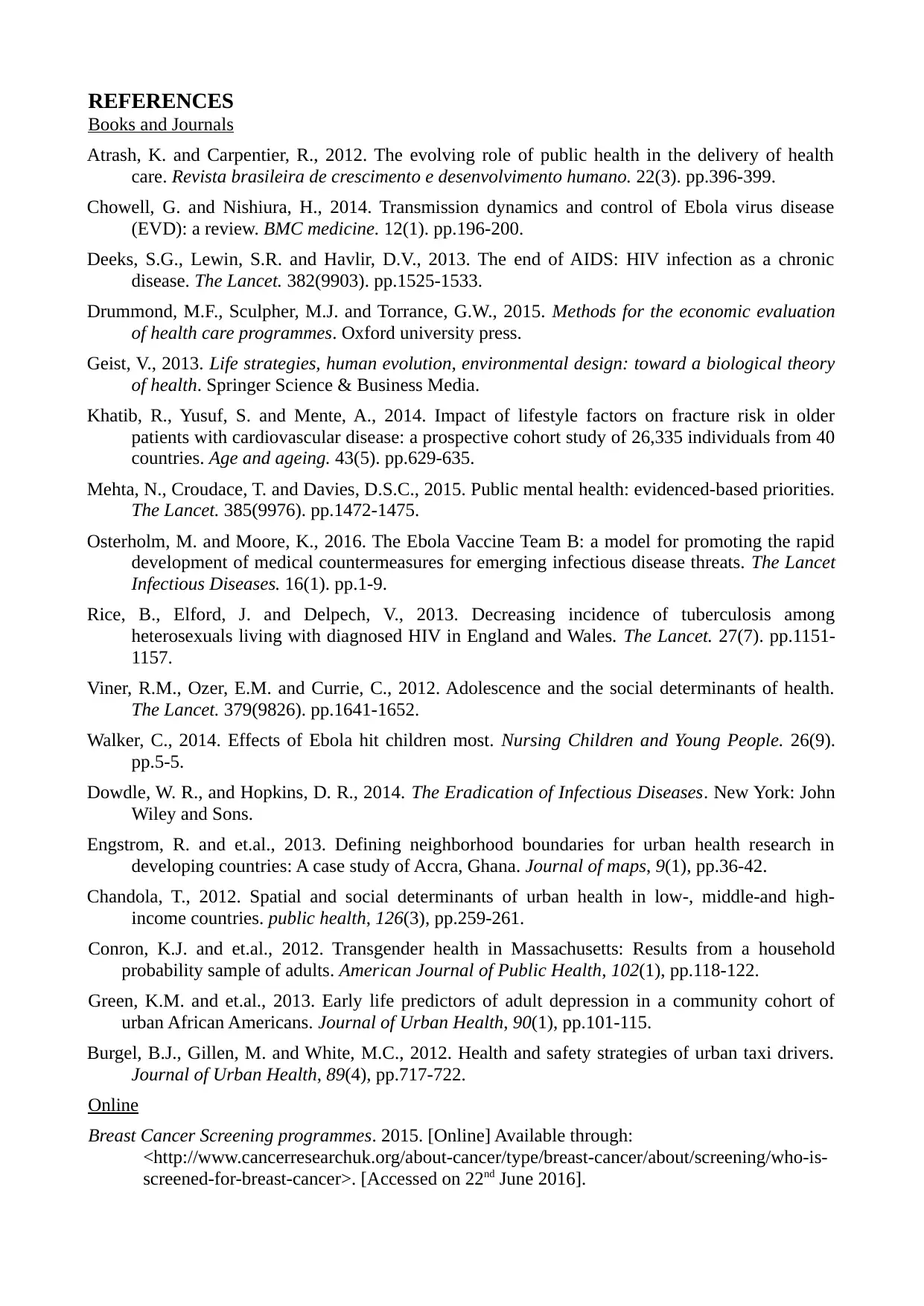
REFERENCES
Books and Journals
Atrash, K. and Carpentier, R., 2012. The evolving role of public health in the delivery of health
care. Revista brasileira de crescimento e desenvolvimento humano. 22(3). pp.396-399.
Chowell, G. and Nishiura, H., 2014. Transmission dynamics and control of Ebola virus disease
(EVD): a review. BMC medicine. 12(1). pp.196-200.
Deeks, S.G., Lewin, S.R. and Havlir, D.V., 2013. The end of AIDS: HIV infection as a chronic
disease. The Lancet. 382(9903). pp.1525-1533.
Drummond, M.F., Sculpher, M.J. and Torrance, G.W., 2015. Methods for the economic evaluation
of health care programmes. Oxford university press.
Geist, V., 2013. Life strategies, human evolution, environmental design: toward a biological theory
of health. Springer Science & Business Media.
Khatib, R., Yusuf, S. and Mente, A., 2014. Impact of lifestyle factors on fracture risk in older
patients with cardiovascular disease: a prospective cohort study of 26,335 individuals from 40
countries. Age and ageing. 43(5). pp.629-635.
Mehta, N., Croudace, T. and Davies, D.S.C., 2015. Public mental health: evidenced-based priorities.
The Lancet. 385(9976). pp.1472-1475.
Osterholm, M. and Moore, K., 2016. The Ebola Vaccine Team B: a model for promoting the rapid
development of medical countermeasures for emerging infectious disease threats. The Lancet
Infectious Diseases. 16(1). pp.1-9.
Rice, B., Elford, J. and Delpech, V., 2013. Decreasing incidence of tuberculosis among
heterosexuals living with diagnosed HIV in England and Wales. The Lancet. 27(7). pp.1151-
1157.
Viner, R.M., Ozer, E.M. and Currie, C., 2012. Adolescence and the social determinants of health.
The Lancet. 379(9826). pp.1641-1652.
Walker, C., 2014. Effects of Ebola hit children most. Nursing Children and Young People. 26(9).
pp.5-5.
Dowdle, W. R., and Hopkins, D. R., 2014. The Eradication of Infectious Diseases. New York: John
Wiley and Sons.
Engstrom, R. and et.al., 2013. Defining neighborhood boundaries for urban health research in
developing countries: A case study of Accra, Ghana. Journal of maps, 9(1), pp.36-42.
Chandola, T., 2012. Spatial and social determinants of urban health in low-, middle-and high-
income countries. public health, 126(3), pp.259-261.
Conron, K.J. and et.al., 2012. Transgender health in Massachusetts: Results from a household
probability sample of adults. American Journal of Public Health, 102(1), pp.118-122.
Green, K.M. and et.al., 2013. Early life predictors of adult depression in a community cohort of
urban African Americans. Journal of Urban Health, 90(1), pp.101-115.
Burgel, B.J., Gillen, M. and White, M.C., 2012. Health and safety strategies of urban taxi drivers.
Journal of Urban Health, 89(4), pp.717-722.
Online
Breast Cancer Screening programmes. 2015. [Online] Available through:
<http://www.cancerresearchuk.org/about-cancer/type/breast-cancer/about/screening/who-is-
screened-for-breast-cancer>. [Accessed on 22nd June 2016].
Books and Journals
Atrash, K. and Carpentier, R., 2012. The evolving role of public health in the delivery of health
care. Revista brasileira de crescimento e desenvolvimento humano. 22(3). pp.396-399.
Chowell, G. and Nishiura, H., 2014. Transmission dynamics and control of Ebola virus disease
(EVD): a review. BMC medicine. 12(1). pp.196-200.
Deeks, S.G., Lewin, S.R. and Havlir, D.V., 2013. The end of AIDS: HIV infection as a chronic
disease. The Lancet. 382(9903). pp.1525-1533.
Drummond, M.F., Sculpher, M.J. and Torrance, G.W., 2015. Methods for the economic evaluation
of health care programmes. Oxford university press.
Geist, V., 2013. Life strategies, human evolution, environmental design: toward a biological theory
of health. Springer Science & Business Media.
Khatib, R., Yusuf, S. and Mente, A., 2014. Impact of lifestyle factors on fracture risk in older
patients with cardiovascular disease: a prospective cohort study of 26,335 individuals from 40
countries. Age and ageing. 43(5). pp.629-635.
Mehta, N., Croudace, T. and Davies, D.S.C., 2015. Public mental health: evidenced-based priorities.
The Lancet. 385(9976). pp.1472-1475.
Osterholm, M. and Moore, K., 2016. The Ebola Vaccine Team B: a model for promoting the rapid
development of medical countermeasures for emerging infectious disease threats. The Lancet
Infectious Diseases. 16(1). pp.1-9.
Rice, B., Elford, J. and Delpech, V., 2013. Decreasing incidence of tuberculosis among
heterosexuals living with diagnosed HIV in England and Wales. The Lancet. 27(7). pp.1151-
1157.
Viner, R.M., Ozer, E.M. and Currie, C., 2012. Adolescence and the social determinants of health.
The Lancet. 379(9826). pp.1641-1652.
Walker, C., 2014. Effects of Ebola hit children most. Nursing Children and Young People. 26(9).
pp.5-5.
Dowdle, W. R., and Hopkins, D. R., 2014. The Eradication of Infectious Diseases. New York: John
Wiley and Sons.
Engstrom, R. and et.al., 2013. Defining neighborhood boundaries for urban health research in
developing countries: A case study of Accra, Ghana. Journal of maps, 9(1), pp.36-42.
Chandola, T., 2012. Spatial and social determinants of urban health in low-, middle-and high-
income countries. public health, 126(3), pp.259-261.
Conron, K.J. and et.al., 2012. Transgender health in Massachusetts: Results from a household
probability sample of adults. American Journal of Public Health, 102(1), pp.118-122.
Green, K.M. and et.al., 2013. Early life predictors of adult depression in a community cohort of
urban African Americans. Journal of Urban Health, 90(1), pp.101-115.
Burgel, B.J., Gillen, M. and White, M.C., 2012. Health and safety strategies of urban taxi drivers.
Journal of Urban Health, 89(4), pp.717-722.
Online
Breast Cancer Screening programmes. 2015. [Online] Available through:
<http://www.cancerresearchuk.org/about-cancer/type/breast-cancer/about/screening/who-is-
screened-for-breast-cancer>. [Accessed on 22nd June 2016].

Public healthcare. 2015. [Online] Available through: <http://www.open.edu/openlearn/health-
sports-psychology/health/public-health/introducing-public-health/content-section-0>.
[Accessed on 22nd June 2016]
sports-psychology/health/public-health/introducing-public-health/content-section-0>.
[Accessed on 22nd June 2016]
1 out of 12
Related Documents
Your All-in-One AI-Powered Toolkit for Academic Success.
+13062052269
info@desklib.com
Available 24*7 on WhatsApp / Email
![[object Object]](/_next/static/media/star-bottom.7253800d.svg)
Unlock your academic potential
© 2024 | Zucol Services PVT LTD | All rights reserved.





